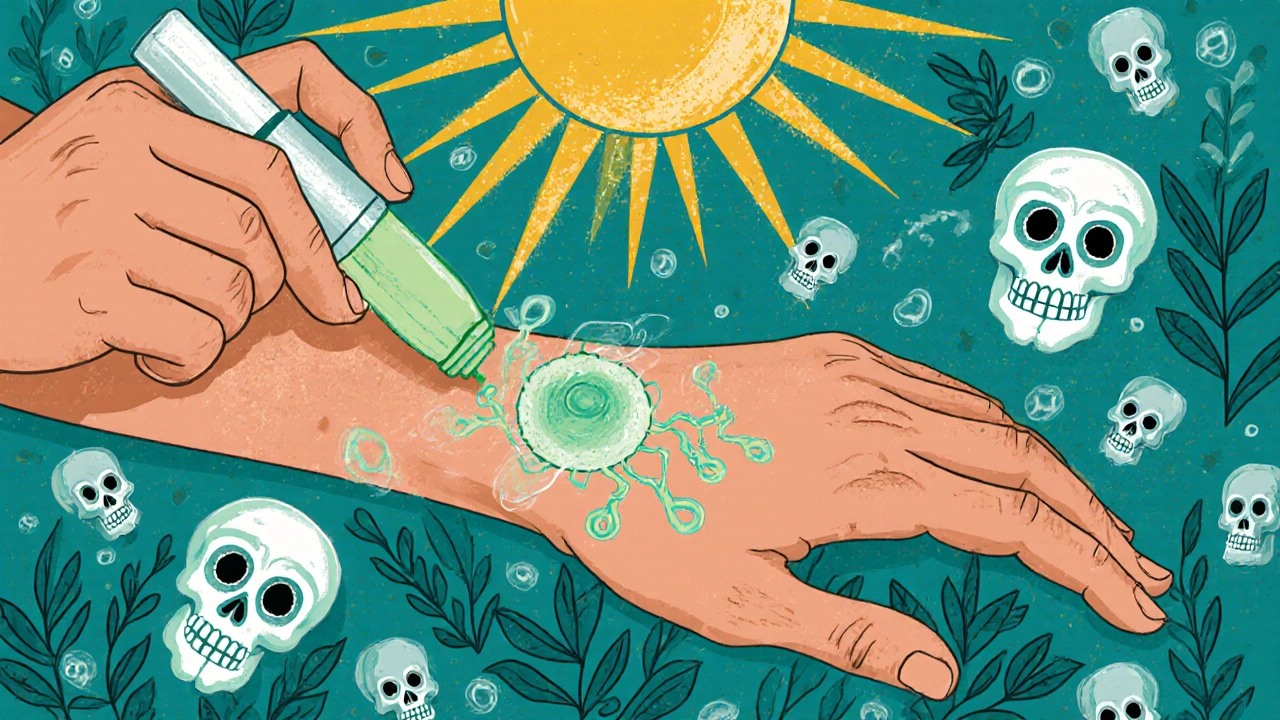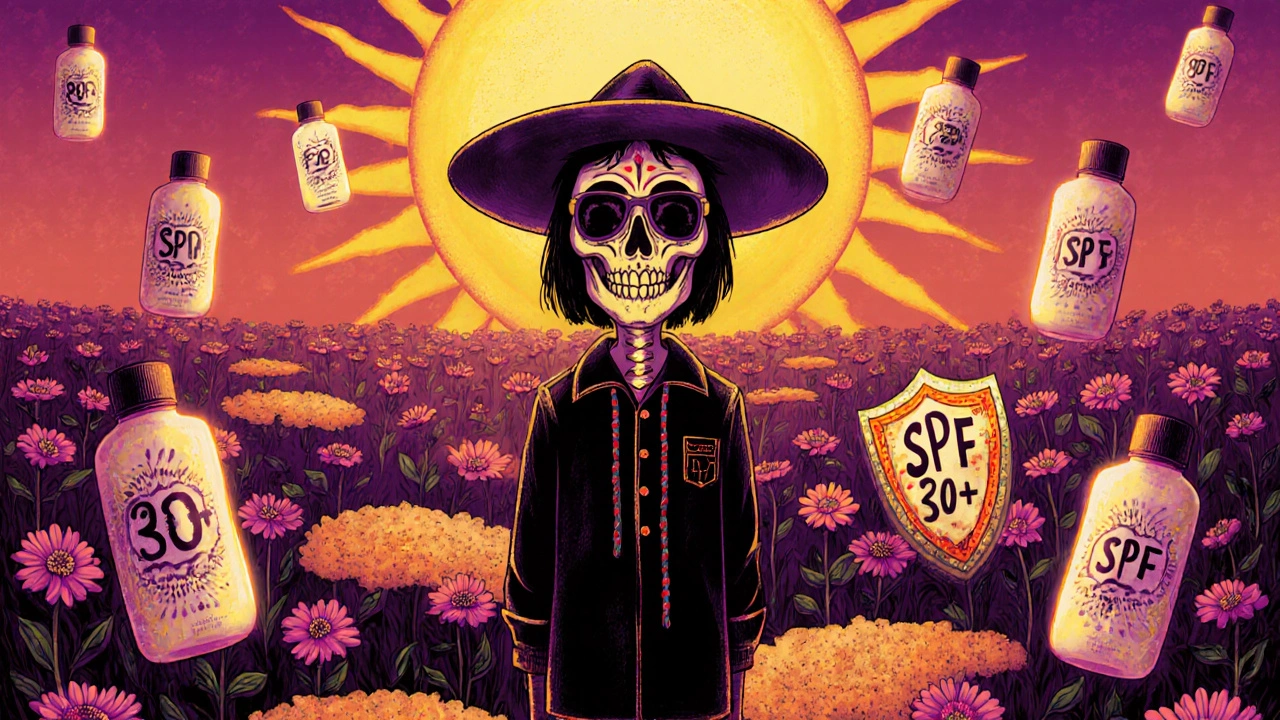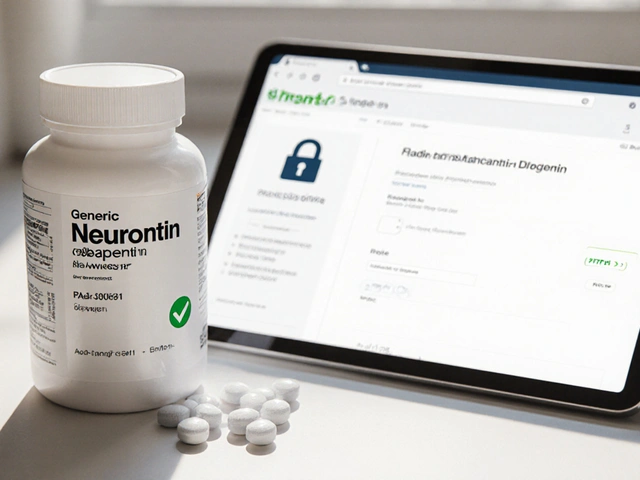Most people think of skin cancer as something that shows up as a weird mole or a dark spot that won’t go away. But the real danger often starts much earlier-with rough, scaly patches you might not even notice until you run your fingers over them. These are actinic keratoses, and they’re not just annoying dry skin. They’re precancers. Left alone, they can turn into squamous cell carcinoma, the second most common type of skin cancer. The good news? When caught early, they’re almost always treatable-and field treatments can stop them before they spread.
What Exactly Are Actinic Keratoses?
Actinic keratoses (AKs) are rough, dry patches on skin that form after years of sun exposure. They don’t appear overnight. It takes decades of UV damage-sunburns, tanning, even just daily exposure-to trigger them. You’ll usually find them on your face, scalp, ears, neck, forearms, and the backs of your hands. These are the spots you’ve been out in the sun without protection for years. They’re often more felt than seen. Run your finger over your cheek or the back of your hand. If you feel something gritty, like sandpaper, that’s a classic sign. They can be red, pink, brown, or even skin-colored. In people with darker skin, they sometimes look like age spots. Size varies too-from tiny spots under a quarter inch to patches up to an inch across. Some develop thick, horn-like bumps, which are a red flag for higher cancer risk. According to the American Academy of Dermatology, about 58 million Americans have actinic keratoses. That’s nearly one in six adults. And it’s not just older people. Anyone with fair skin, a history of sunburns, or who spends time outdoors is at risk. The damage builds up slowly, so you might not see the results until you’re in your 40s or 50s.Why They’re More Than Just a Cosmetic Issue
Here’s the thing most people don’t realize: actinic keratoses aren’t just warning signs-they’re early-stage skin cancer. Dermatologists now call them in situ squamous cell carcinomas. That means the cancer cells are still stuck in the top layer of skin, but they’re there. About 10% of people with more than 10 AKs will develop invasive squamous cell carcinoma at some point. For those with weakened immune systems, that risk jumps to 25%. The Skin Cancer Foundation says 90% of all squamous cell carcinomas start as untreated actinic keratoses. That’s not a guess. It’s backed by decades of research. Treating AKs isn’t about improving how your skin looks-it’s about stopping cancer before it spreads. A biopsy isn’t always needed. Board-certified dermatologists can identify AKs with 95% accuracy just by looking and feeling them. If a patch becomes tender, bleeds, grows quickly, or turns into an open sore, that’s when you need a biopsy to rule out deeper invasion.Field Treatment: Treating the Whole Area, Not Just the Patches
You might think, “I’ll just treat the one rough spot on my nose.” But here’s the problem: UV damage doesn’t stop at the edge of a visible lesion. Underneath healthy-looking skin, there’s often invisible damage-what doctors call “field cancerization.” That’s why treating just one patch isn’t enough. Field treatments go beyond individual lesions. They target the entire sun-damaged area to clear out precancerous cells before they turn into full-blown cancers. There are three main types of field treatments:- Topical creams and gels-These are applied daily for weeks. The most common are 5% fluorouracil (5-FU), imiquimod, tirbanibulin, and ingenol mebutate. 5-FU clears 75-85% of lesions after 2-4 weeks. But it comes with a catch: your skin gets red, swollen, and crusty. That’s the medicine working. Many patients say it feels like a bad sunburn, but it’s a sign the damaged cells are dying.
- Chemical peels-Trichloroacetic acid (TCA) peels are used for thicker AKs. A dermatologist applies the solution, which burns off the top layer of damaged skin. Healing takes about a week. It’s fast, but not for everyone-especially if you have sensitive skin.
- Photodynamic therapy (PDT)-This one’s a two-step process. First, a light-sensitive solution (aminolevulinic acid) is applied to the skin. After a few hours, you sit under a special blue or red light that activates the drug and destroys abnormal cells. It’s effective, especially for large areas like the scalp or forehead. Most people need one or two sessions.

Which Treatment Is Right for You?
There’s no one-size-fits-all answer. It depends on where the lesions are, how many you have, your skin type, and how much discomfort you’re willing to tolerate. For example, if you have several AKs on your face and you want something quick, tirbanibulin (Klisyri) might be your best bet. It’s a 5-day treatment with fewer side effects than 5-FU. But it costs about $650 per course. Generic 5-FU? Around $120. If cost matters and you’re okay with a longer process, 5-FU still works great. Imiquimod is another option-it’s applied three times a week for up to 16 weeks. It’s less irritating than 5-FU, but takes longer. Some patients like it because the skin reaction is milder. Photodynamic therapy is great for larger areas, especially if you’re not keen on daily creams. It’s covered by most insurance, and results are visible within weeks. But you have to avoid sunlight for 48 hours after treatment-no driving, no walking the dog, no sitting by the window. A 2023 study in JAMA Dermatology found that combining 5-FU with PDT cleared 92% of lesions-better than either treatment alone. That’s becoming a go-to strategy for stubborn cases.What to Expect During Treatment
No field treatment is gentle. You’ll likely experience redness, peeling, stinging, and crusting. That’s normal. In fact, it’s a sign the treatment is working. But it’s also why so many people quit early. A Cleveland Clinic study found 61% of patients on 5-FU had to pause treatment because the reaction was too intense. Here’s what to do if it gets bad:- Don’t pick or scratch. Let the skin heal naturally.
- Use fragrance-free moisturizers to soothe dryness.
- Apply cool compresses to reduce burning.
- Stick to your schedule, even if it’s uncomfortable. Stopping early means the damage might come back.
Prevention: The Real Long-Term Solution
Treating AKs is important, but preventing new ones is even more powerful. Studies show that patients who get proper sun protection counseling reduce new AKs by 37% over two years. That’s not a small number. It’s life-changing. Here’s what works:- Wear broad-spectrum SPF 30+ sunscreen every day-even in winter or on cloudy days.
- Use wide-brimmed hats and UV-blocking sunglasses.
- Avoid direct sun between 10 a.m. and 4 p.m.
- Don’t use tanning beds. Ever.
- Check your skin monthly. Use the “sandpaper test”: run your fingers over sun-exposed areas. If anything feels rough, see a dermatologist.

What’s Next for AK Treatment?
Research is moving fast. New drugs are being tested to target specific genetic changes in AK cells. There’s also early work on treatments that adjust the skin’s microbiome to help fight precancerous growths. But the biggest shift is in awareness. More people are learning that AKs aren’t just “old age spots.” They’re early cancer. The global market for AK treatments hit $1.34 billion in 2022. That’s not because people are buying more creams-it’s because more people are getting diagnosed and treated. In places like Arizona and California, up to 60% of fair-skinned people over 40 have AKs. In northern Europe, it’s closer to 15%. The difference? Sun exposure. With climate change and longer, hotter summers, experts predict AK cases will rise 25% by 2030. That means early detection and field treatments aren’t just medical options-they’re public health necessities.Frequently Asked Questions
Are actinic keratoses the same as warts?
No. Warts are caused by a virus (HPV) and usually appear as raised, bumpy growths. Actinic keratoses are caused by sun damage and feel rough and scaly, like sandpaper. They’re flat or slightly raised and often appear in clusters on sun-exposed skin. Warts can spread through contact; AKs do not.
Can actinic keratoses go away on their own?
Sometimes, yes-but it’s rare and unreliable. A small number of AKs may fade temporarily, especially if you stop sun exposure. But they almost always come back. Even if they disappear, the underlying damage remains. That’s why dermatologists don’t recommend waiting. Leaving them alone increases your risk of skin cancer.
Is it safe to scrape off an actinic keratosis myself?
Never. Trying to pick, scratch, or peel off an AK can cause bleeding, infection, and scarring. It also doesn’t remove the damaged cells underneath. Only a dermatologist can safely treat them with methods that target the full depth of the damage. Self-treatment increases cancer risk.
How long does it take for field treatments to work?
It varies. Topical creams like 5-fluorouracil usually take 2-4 weeks to show results, with full healing taking another 2-4 weeks after stopping. Imiquimod can take up to 16 weeks. Photodynamic therapy often shows improvement within 1-2 weeks, with final results visible after 4-6 weeks. Patience is key-results aren’t instant, but they’re lasting.
Will I need more than one treatment?
Most people do. Even after successful treatment, new AKs can develop because sun damage is cumulative. Many patients need repeat treatments every 6-12 months, especially if they continue to have sun exposure. Maintenance is part of long-term skin cancer prevention.
Do I need to see a dermatologist, or can my family doctor treat AKs?
Family doctors can identify and treat simple cases, but dermatologists are specialists in skin cancer. They have more experience with field treatments, can use dermatoscopes for accurate diagnosis, and know how to handle complex or stubborn lesions. If you have more than a few AKs, or if they’re on your face or scalp, seeing a dermatologist gives you the best chance of complete clearance.








